Beating the Bots: Why Qualified Blockchain Professionals Aren’t Getting Calls And How to Fix It
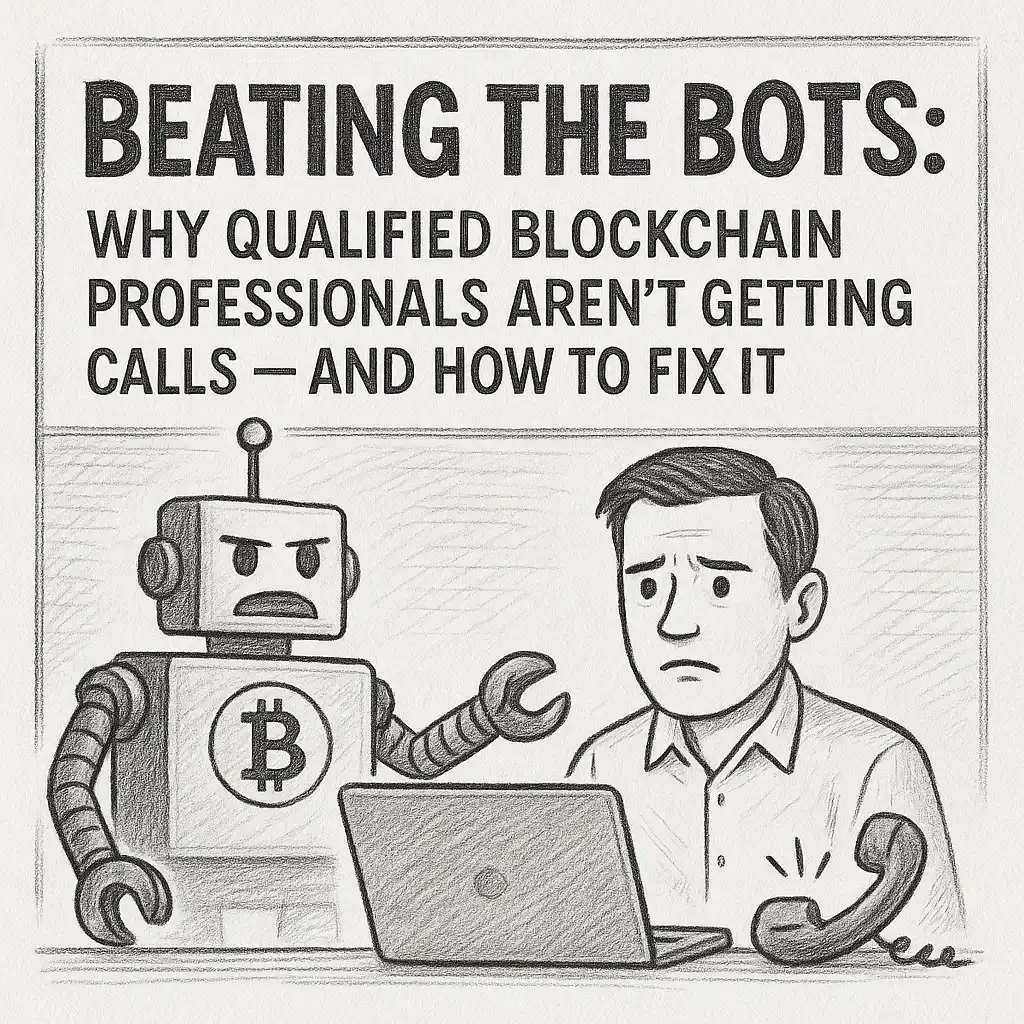
The Hidden Crisis in Blockchain Hiring
Finding a Web3 job today isn’t just hard — it’s confusing. You might have spent months mastering Solidity, EVM internals, Rust basics, smart-contract testing patterns, or even zk-concepts, yet your inbox stays empty. Many blockchain professionals quietly battle the same fear:
“Am I not good enough?”
The uncomfortable reality is that most candidates aren’t rejected because they lack skills.
They’re rejected because they’re invisible.
Web3 hiring operates on a different axis:
global competition + automation + overloaded recruiters.
A role posted in Dubai, Austin, Berlin, or Hong Kong isn’t “local talent only.” It immediately attracts candidates across Asia, LATAM, Eastern Europe, Africa, US, EU — all fighting for the same 5–10 interview slots.
For example:
Remote jobs make up only ~18% of listings worldwide
But they receive over 50% of applications (LinkedIn 2024 Talent Trends)
In Web3, where 70%+ roles are remote, the imbalance is far worse
You aren’t competing with your city.
You aren’t competing with your country.
You’re competing with the world.
But global competition is only one layer. The bigger challenge sits silently in the background:
ATS filters, AI resume-rankers, keyword engines, and parsing algorithms that reject you before any human ever evaluates your skills.
AOB members echo the same frustration:
“I match everything. I’ve shipped real projects. But it feels like no human is reading my resume.”
(https://artofblockchain.club/discussion/how-to-explain-blockchain-career-gap-in-interviews)
This guide isn’t about “generic job tips.”
It’s about understanding how the Web3 hiring machinery works — and how to break through it with visibility, clarity, and proof.
⭐ TL;DR — Why Blockchain Professionals Aren’t Getting Calls (And How to Fix It)
Most rejections happen before humans see your resume — ATS filters misread modern templates, missing keywords, and formatting issues.
Global competition is extreme — every remote Web3 job attracts applicants from 20+ countries within hours.
Job descriptions are inflated — founders list “dream skills,” but usually hire candidates who meet 60–70% of the requirements.
Recruiters trust proof, not polish — GitHub activity, tests, security notes, and reasoning matter more than perfect bullet points.
Simple, test-covered repos outperform complex, unclear ones — clarity + consistency = credibility.
Most candidates lose due to visibility, not ability — fixing ATS issues + building a proof-driven portfolio dramatically increases callbacks
ATS Filters: The First Battle Candidates Don’t See
Most blockchain professionals assume hiring begins when a recruiter reviews a resume.
In reality, hiring begins when an ATS system scans your resume for keywords, formatting, and structure — and silently decides your fate.
Up to 75% of resumes never reach a human (Jobscan / Indeed Hiring Lab).
And blockchain resumes get rejected more often because the toolchains are extremely specific.
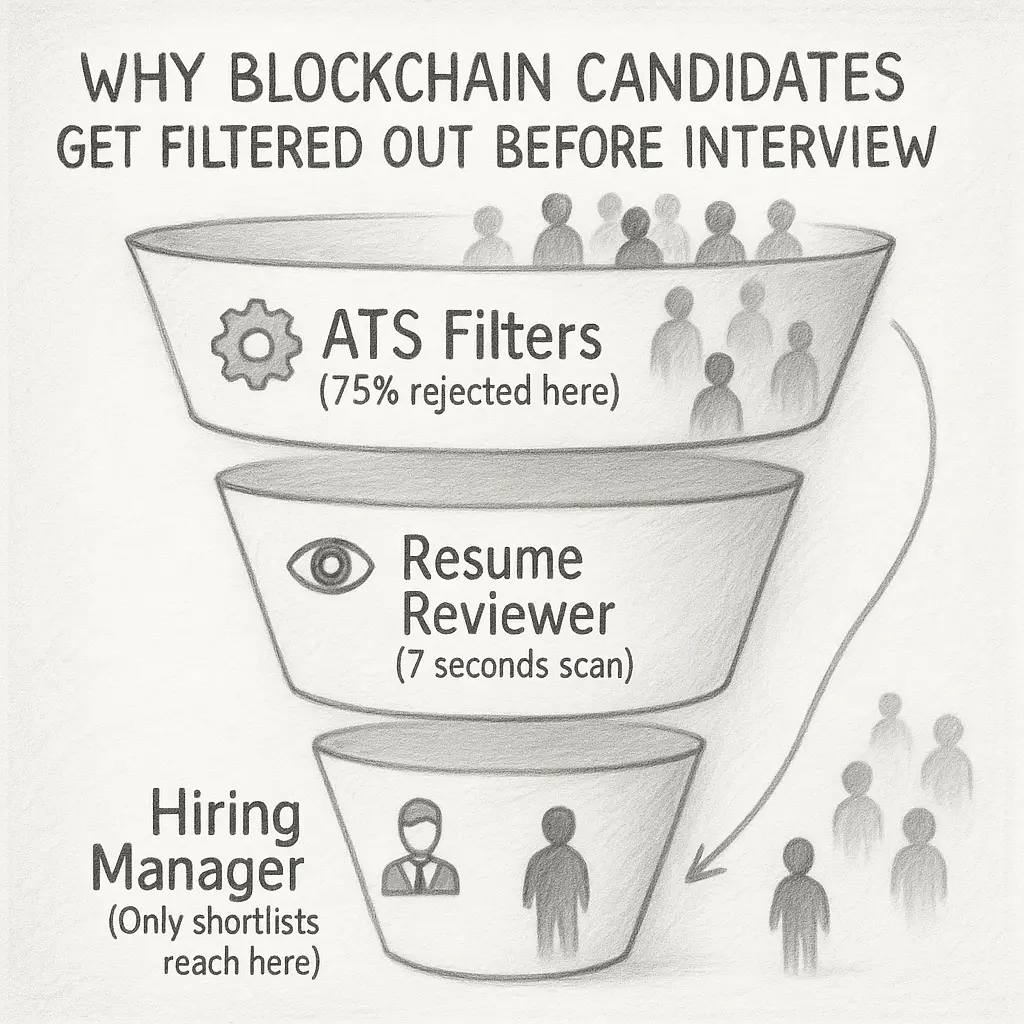
Why Blockchain Resumes Fail More Than Others
The collapses usually happen for four reasons:
1. Missing exact tool keywords
ATS engines are literal. They do not infer context.
“Smart-contract tests” ≠ “Foundry tests”
“Security review” ≠ “Slither static analysis”
“Optimized performance” ≠ “gas optimization (EVM)”
If the JD says: Solidity, Hardhat, Foundry, Slither, Tenderly, ERC20, zk basics…
Your resume must mirror these exact strings.
2. Modern CV templates break ATS parsing
Most Canva/Figma resumes fail because ATS cannot read:
Columns
Tables
Icons
Logos
Text boxes
Layered PDFs
What looks clean to a human looks blank to an ATS.
3. No dedicated Skills & Tools section
When tools are buried inside paragraphs, ATS often never detects them — resulting in automatic rejection.
4. Synonym mismatches
Tiny differences destroy match scores.
Examples:
“fuzzing” ≠ “Foundry forge fuzzing”
“smart-contract QA” ≠ “Solidity testing”
This explains why so many qualified AOB users face silent rejections:
https://artofblockchain.club/discussion/am-i-missing-anything-major-on-my-resume-for-a-web3blockchain-career
How to Write Blockchain Resume Bullets Correctly
Most Web3 resume bullets are too vague.
❌ Bad:
“Worked on staking contract.”
✔ Good:
“Built staking contract (Solidity, EVM) with Foundry tests; improved gas by 12% using loop restructuring.”
The difference is dramatic:
ATS sees tool-match
Recruiters see proof
You earn callbacks
ATS Survival Steps That Increase Visibility Immediately
Here’s the condensed system Web3 candidates use to increase callback rates 2×–3×:
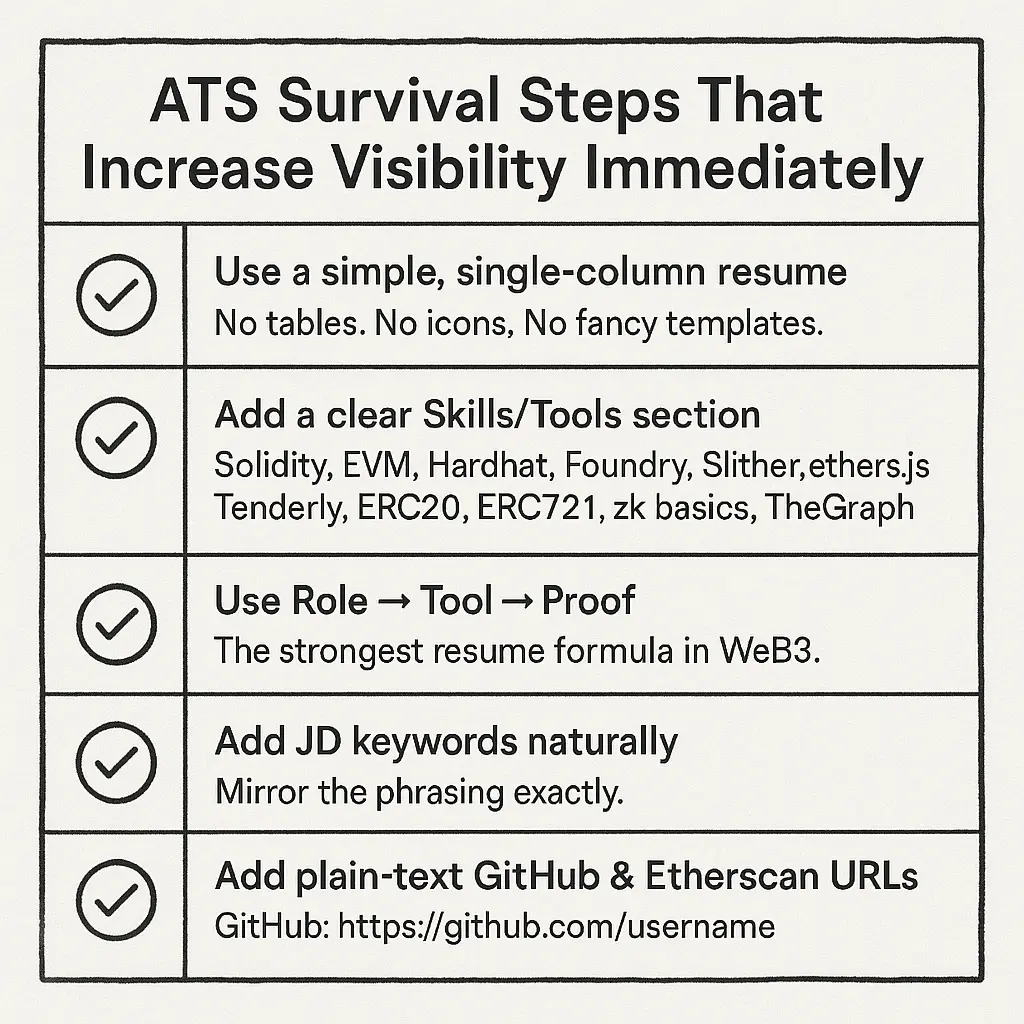
For deeper reference:
https://artofblockchain.club/article/blockchain-developer-resume-masterclass-2025-the-complete-guide-for-every-web3-job
“Most Web3 candidates don’t lose because they lack skills.
They lose because their resumes don’t survive the first automated checkpoint.
Once your resume becomes ATS-friendly, the entire hiring pipeline opens up — and the remaining stages finally become accessible.”
Global Remote Competition: Why “Qualified” Isn’t Enough Anymore
The Web3 job market resembles a global hackathon—everyone can join, everyone can apply, and everyone can compete instantly. A role posted at 3 AM in Singapore receives applicants from Argentina, India, Nigeria, Germany, and Canada before the hiring manager wakes up.
This borderless market is exciting for companies… and brutal for candidates.

There are four invisible forces shaping your chances—forces most applicants never notice.
1. Salary Arbitrage Decides Who Gets Shortlisted First
Founders operate under burn pressure. Even when candidates have matching skills, they compare global salary expectations.
Example:
A strong mid-level blockchain developer in the U.S. expects $120k–$160k.
A strong mid-level developer from LATAM/Eastern Europe/India may expect $30k–$60k.
Hiring teams often shortlist the “aligned compensation band” first, even when skills are equal.
It’s not personal—it’s survival.
2. Most Callbacks Happen in the First 36 Hours
Blockchain job postings often receive 200–400 applications.
Shortlisting starts almost immediately.
Data Insight (LinkedIn 2024):
✔ Applying within the first 24–36 hours increases callback chances by 38%.
This means applying late—even by a day or two—automatically places you in the “overflow stack.”
3. “Remote” Still Means Timezone Constraints
Teams rarely write it explicitly, but Web3 startups prefer candidates within ±3–4 hours of their engineering timezone.
Why?
Faster async communication
Easier stand-ups
PR reviews in overlapping windows
Reduced coordination overhead
If you're 7–10 hours off, your resume may be silently filtered out.
4. Communication Style Determines Trust
In global remote teams, communication is a skill—not a soft skill, but a work competency.
Founders subconsciously filter candidates who write:
long, dense paragraphs
overly formal answers
unclear explanations
vague technical reasoning
Sharp, concise writing creates trust.
If you want to practice this, use this AOB thread:
https://artofblockchain.club/discussion/how-do-i-pitch-myself-to-blockchain-founders-in-60-seconds
Action Steps to Win Global Competition
Here’s how strong candidates increase their chances:
Apply on Day 1 (set alerts; respond fast)
Add timezone overlap (“4–5 hours overlap with PST / CET / SGT”)
Show region-relevant strengths:
India → Polygon ecosystem, EVM depth
EU → Substrate / ink! / Rust
Asia → infra ops, node operations
Use async-friendly GitHub documentation
Clear READMEs, clean repos, test coverage → instant credibility.
Skill Mismatch vs Job Description Inflation in Web3
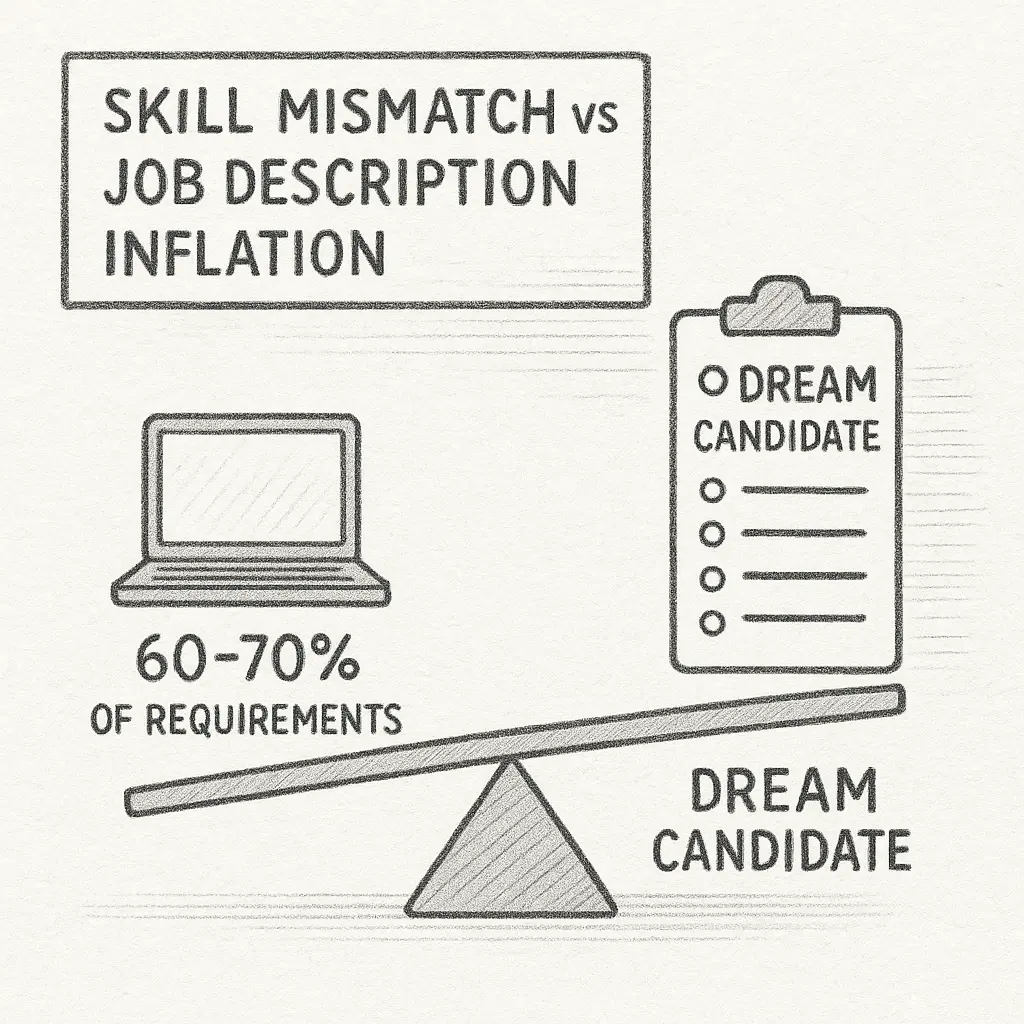
If you’ve ever read a blockchain job description and felt like they want a full-stack Solidity + DevOps + Security + Product hybrid… you’re not wrong.
Web3 JDs are notoriously inflated.
And most aren’t written by recruiters—they’re written by founders juggling 20 responsibilities.
Understanding why JDs look so unrealistic can immediately reduce your anxiety and stop unnecessary self-rejection.
1. Founders Write “Dream Candidate” JDs
Early-stage blockchain companies often have no hiring team. The founder manages:
product
audits
growth
security
infra
partnerships
So when they write JDs, they describe an idealized superhuman — not the actual person they expect to hire.
That’s why you see absurd combinations like:
“3+ years Solidity + 3+ years Rust”
“Full audit experience + frontend + backend”
“zk knowledge + UX design sense”
“DevOps + smart contract testing + community operations”
These are not real expectations.
They’re wishlists.
Candidates take them literally and self-reject, even though founders usually hire someone with 60–70% of the listed requirements.
2. JD Copy-Pasting From Big Companies Creates Panic
A 12-person DeFi startup copy-pasting roles from Coinbase, a16z companies, or Consensys is extremely common.
Why?
“This sounds professional.”
“We’ll shortlist from here anyway.”
“We’ll see who applies.
The result?
Candidates see intimidating JDs and assume they must master everything before applying.
This is incorrect.
3. Recruiters Don’t Understand Rapidly Evolving Toolchains
Blockchain is one of the fastest-changing tech sectors.
Foundry → grew from <5% to 50%+ adoption in 18 months
New zk frameworks update quarterly
Security tooling evolves monthly
Cairo, Move, and Sway emerged recently
Recruiters can't keep up.
To avoid missing anything, they list every buzzword imaginable.
This creates fear in candidates who think they’re underqualified, when in reality companies only need a small subset of that list.
4. The REAL Hiring Signal: Skill Adjacency
Web3 founders hire for adaptability, not perfection.
Examples of adjacency:
Web2 backend → EVM logic, modifiers, events
QA testers → invariant tests, fuzzing, audit-style testing
Cybersecurity → Slither, threat modeling
DevOps → RPC infra, node ops
Rust devs → Substrate, Solana, ink!
Understanding adjacency immediately expands your eligibility for multiple roles.
For full transitions:
https://artofblockchain.club/article/how-to-transition-from-web2-to-web3-jobs-swiftly-strategically
What You Should Actually Do
Here’s the practical way to handle inflated JDs:
Apply when you meet even 60–70% of the listing
Translate your past work into Web3 language
Web2 backend → “state transition logic”
Web2 testing → “smart-contract testing patterns”
Build a JD translation sheet:
Required tools
Optional buzzwords
Actual proof needed
Hidden signals (documentation, async skill, reasoning)
This removes fear and boosts confidence.
Global roles create extraordinary competition, but most candidates misunderstand the actual expectations.
Hiring teams don’t want unicorns — they want adaptable, proof-driven contributors with clear thinking.
Master ATS + apply early + show proofs + stop self-rejecting because of inflated JDs — and you’re already ahead of most applicants.
Recruiter Psychology: Why They Don’t Call Even When You’re Qualified
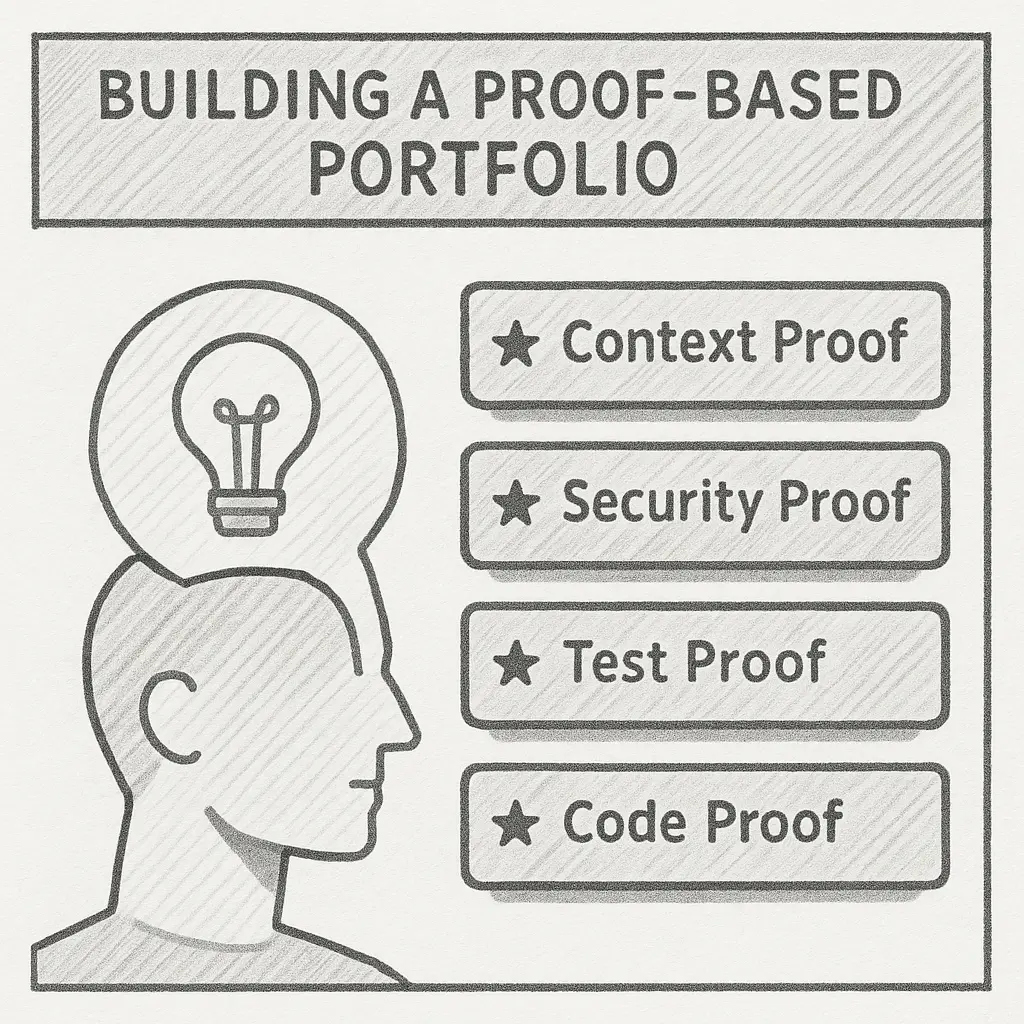
Many blockchain candidates take silence personally.
But hiring managers aren't ignoring you — they’re overwhelmed.
Web3 hiring runs on chaos: multiple roles, tight deadlines, founder pressure, and fast-moving toolchains. Recruiters don’t have the luxury to evaluate every applicant deeply.
Understanding how recruiters think changes everything.
1. Recruiters Face Volume You Don’t See
For a typical week, a recruiter might handle:
5–7 active roles
200–300 applicants per role
1,000–1,500 resumes total
It’s humanly impossible to give thoughtful attention to each resume.
So they rely on pattern recognition, not deep evaluation.
Quick filters dominate:
GitHub activity
Clear formatting
Obvious toolchain relevance
Familiar patterns (Hardhat, Foundry, Slither)
Clean explanation
Your resume gets 7 seconds of attention — confirmed by Ladders eye-tracking studies.
Are you struggling to polish get web3 portfolio , read our blog
Proof-Heavy Smart Contract Portfolios: What Hiring Managers Actually Trust (2025 Edition)
2. AI-Polished Resumes Lower Trust
ChatGPT made everyone’s resume clean.
Recruiters know this.
They see dozens of candidates with:
perfect grammar
perfect formatting
perfect bullet structure
perfect summaries
Because of this, they trust proof, not polish.
The one thing AI can’t fake?
Your actual work.
Examples of authentic proof:
GitHub commits
Etherscan deployments
Foundry tests
Slither reports
Security notes
Gas-optimization decisions
Clean READMEs
PR comments
Proof lifts you above the ocean of polished-but-empty resumes.
3. Recruiters Minimize “Risk,” Not Maximize “Potential”
This is the most misunderstood part of blockchain hiring.
Recruiters are not trying to find the “best” candidate.
They are trying to avoid the worst-case hire.
Risk factors include:
Empty GitHub repos
No tests
Over-polished resume with no proof
Big employment gaps without explanation
Tool claims without evidence
No test coverage
Web3 is unforgiving — one poorly written contract can cost millions.
This makes recruiters extremely cautious.
They prefer:
Less experience + strong proof
over
More experience + weak proof
Because the former is easier to trust.
Are you struggling with How Recruiters Read Your GitHub (2025): Building Proof Stacks for Blockchain Trust Read our blog
4. The Four Proof Signals Recruiters Trust Most
Here are the exact signals recruiters scan for within seconds:
✔ 1. Code Proof
Recency, readability, clarity, consistency.
✔ 2. Test Proof
Hardhat or Foundry tests, fuzzing, negative tests, gas reports.
✔ 3. Security Proof
Slither findings, invariant checks, mitigation notes.
✔ 4. Context Proof
The rarest — and most powerful.
Context proof = your reasoning and decision-making:
README explanations
Architecture notes
Why you chose X over Y
Gas trade-offs
Edge-case thinking
AOB threads where you explain your design choices
For a deeper breakdown:
https://artofblockchain.club/article/how-recruiters-read-your-github-2025-building-proof-stacks-for-blockchain-trust
5. How to Look Like a “Low-Risk Candidate” Instantly
Add lines like:
“Improved gas by 11% using unchecked blocks”
“Added 15 invariant tests”
“Identified 3 medium-risk issues using Slither”
“Deployed contracts on Scroll testnet (link below)”
“Wrote 40+ Foundry tests covering reverts/fuzzing/edge cases”
These calm recruiter anxiety immediately.
Building a Proof-Based Portfolio (Your Real Differentiator)
Almost every Web3 hiring manager agrees on one principle:
Proof beats everything.
Not degrees.
Not years of experience.
Not polished resumes.
Proof = what you can demonstrate today.
This is why juniors with strong proof often beat seniors with weak proof.
And why self-taught devs with solid repos outperform CS grads with empty GitHubs.
Let’s break down the AOB Proof Stack — the mental model recruiters use subconsciously.
⭐ Layer 1: Code Proof (The First Thing Recruiters Check)
Before reading your resume, hiring managers open your GitHub.
They look for:
recent activity (last 2–6 weeks)
readable code
consistent naming
clarity over complexity
original work (not copy-pasted tutorials)
You don’t need advanced protocols to pass this check.
Simple, clean repos impress more than complicated, messy ones:
ERC20 implementation
staking contract
basic vesting
NFT minting logic
borrowing/lending simulation
Tip: Four meaningful repos > one massive repo you can’t explain.
⭐ Layer 2: Test Proof (The Most Common Gap)
Most Web3 resumes claim Hardhat/Foundry…
…but show zero tests.
This kills trust immediately.
Your /test folder speaks louder than your resume.
What hiring managers look for:
unit tests
fuzz tests
revert checks
attacker-behavior tests
naming conventions
gas reports
Even 10–15 tests put you in the top 20% of applicants.
⭐ Layer 3: Security Proof (Shows Maturity)
You don’t need to be an auditor.
You just need awareness.
Security proof includes:
storage layout notes
gas optimization notes
simple audit-style reasoning
Even lines like:
“Checked for reentrancy — safe”
“Unchecked external calls — none”
“Integer overflow — safe due to >=0.8.0”
Signal maturity.
⭐ Layer 4: Context Proof (The Most Valuable Layer)
This is where you separate yourself from 80% of candidates.
Context proof = your thinking.
Hiring managers love candidates who document:
why design choices were made
trade-offs
edge cases
alternative approaches
constraints
You can demonstrate this in:
README files
PR comments
GitHub issues
Architecture notes
AOB discussions where you explain reasoning
This turns your GitHub into a portfolio, not just a repo list.
Reference full model:
https://artofblockchain.club/article/proof-heavy-smart-contract-portfolios-what-hiring-managers-actually-trust-2025-edition
⭐ The Golden Rule of Web3 Proof
If it’s not on-chain, on GitHub, or written publicly —
it doesn’t exist.
This rule determines who gets interviews.
Recruiters don’t ignore you because you’re unqualified.
They ignore you because they can’t trust you yet.
Trust in Web3 is built through proof — not talk.
Once your GitHub, tests, and reasoning are visible, the entire hiring pipeline shifts in your favor.
ATS Survival Toolkit: 10 Fixes That Instantly Improve Your Visibility
Most blockchain candidates don’t struggle with skills — they struggle with visibility.
You can be in the top 5% technically, but if automation screens you out, no recruiter will ever discover your expertise.
This toolkit gives you actionable, immediate fixes to pass ATS filters and get your resume seen by humans.
1. Delete All Fancy Resume Templates
ATS cannot read aesthetics.
It misinterprets or ignores:
columns
tables
icons
graphics
text boxes
layered PDFs (common in Canva)
Use a clean, single-column layout.
Simple beats pretty.
2. Create a Dedicated “Skills & Tools” Section
ATS needs clarity.
List tools exactly as they appear in job descriptions:
Solidity, EVM, Hardhat, Foundry, Slither, Tenderly, ethers.js, ERC20, ERC721, invariant testing, zk basics, TheGraph
No mixing tools inside paragraphs.
3. Use Exact JD Keywords
ATS engines match phrases literally.
Examples:
“Foundry fuzzing”
“Slither static analysis”
“Gas optimization (EVM)”
“Invariant tests”
A small mismatch can cost you a shortlist.
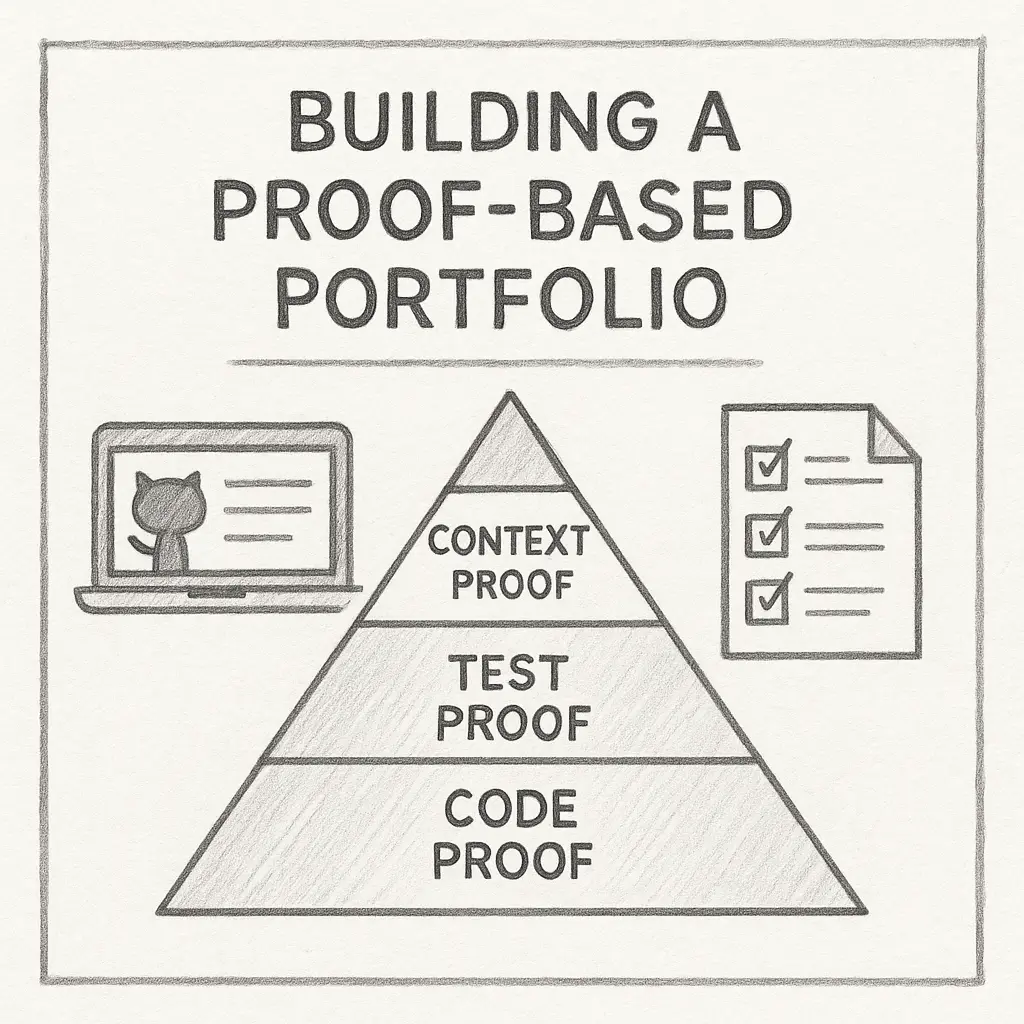
4. Rewrite Bullets Using the Role → Tool → Proof Format
This is the strongest Web3 resume formula.
❌ Bad:
“Worked on vesting contract.”
✔ Good:
“Built token vesting contract (Solidity, EVM) with 20 Foundry tests; reduced execution gas by 14% using unchecked blocks.”
Clear, structured, and ATS-friendly.
5. Add Tool Synonyms to Improve Match Score
Some synonyms ATS considers “different”:
“smart-contract QA” ≠ “Solidity testing”
“gas profiling” ≠ “gas optimization”
“EVM engineering” ≠ “smart-contract development”
Use JD language to improve your match ratio.
6. Keep Your Resume to 1–1.5 Pages
Longer resumes break parsing and create irrelevant noise.
Blockchains roles value focus, not volume.
7. Add GitHub and Etherscan Links as Plain Text
No formatting. No hyperlinking.
GitHub:https://github.com/username
Contract: https://etherscan.io/address/0x123
Plain URLs are ATS-safe and recruiter-friendly.
8. Remove Soft Skills From Skill Sections
ATS may misread “communication” or “leadership” as core skills — lowering match relevance.
Place soft skills inside achievements instead.
9. Add Numbers Wherever Possible
Recruiters scan for metrics because they feel credible.
Examples:
“34 Hardhat tests”
“3 critical bugs found using Slither”
“Reduced gas by 11.2%”
“15 invariant tests added”
Numbers cut through noise.
10. Get a Real Resume Review
Benchmark your resume against real Web3 candidates:
https://artofblockchain.club/discussion/looking-for-a-quick-resume-roast-for-blockchain-dev-roles
Or use the full AOB resume rebuild guide:
The Emotional Toll of Blockchain Job Searching

Searching for blockchain roles is emotionally draining in a uniquely intense way.
The industry is global, competitive, automation-heavy, and constantly evolving — which amplifies self-doubt even for strong candidates.
Many Web3 professionals quietly battle emotional fatigue, imposter syndrome, and invisible pressures that aren’t discussed enough.
Let’s make them visible.
1. Ghosting Feels Personal, Even When It Isn’t
You apply → you wait → then you hear nothing.
Not even a rejection.
Ghosting is the default because recruiters cannot manage the volume, not because you’re unworthy.
But silence feels like judgment, even when it's not.
2. Self-Doubt Creeps In, Even for Skilled Developers
You might be:
learning Solidity patterns
building small projects
writing tests
improving gas
polishing your GitHub
…and still question yourself:
“Maybe I’m not good enough.”
“Maybe Web3 is too competitive.”
“Maybe I should go back to Web2.”
Your skills are not the issue — your visibility is.
3. ATS Rejection Feels Like a Personal Failure
But the real reasons are often simple:
template issues
missing keywords
synonym mismatch
unclear sections
broken PDFs
Most candidates never lose because of their ability — they lose because software misreads them.
4. The Pressure to Constantly Learn Everything
Web3 moves at hyper-speed:
new zk frameworks
Foundry updates
new languages (Cairo, Sway, Move)
new test tooling
new chains
No one can master everything.
Feeling “behind” is normal.
5. Job Loss Feels Devastating in Web3
Blockchain roles involve high ownership, so losing a job feels like personal failure.
Many AOB members have shared this exact fear:
https://artofblockchain.club/discussion/got-removed-from-my-first-blockchain-job-now-scared-to-ask
Your feelings are valid.
Your fear is valid.
Your frustration is valid.
But so is your potential — and your ability to rebuild with clarity and proof.
“Visibility challenges, automation filters, and global competition create emotional strain that many underestimate.
Once you fix ATS barriers and understand the mechanics of proof-driven hiring, the emotional weight begins to lift — because the outcomes finally start to change.”
Final Action Plan: 10-Day ATS Fix + 14-Day Proof Sprint
This is the exact 24-day roadmap used by hundreds of AOB members to break out of the “no-callbacks loop.”
It’s simple, structured, and designed to create immediate visibility + long-term credibility.
⭐ 10-Day ATS Fix Sprint
(Goal: Ensure AI systems and recruiters can finally see you.)
Day 1–2: Rebuild Resume Formatting
Switch to a single-column layout.
Remove tables, icons, PDF layers, and Canva/Figma templates.
Use standard fonts: Inter, Roboto, Arial.
Export as text-based PDF or DOCX.
Day 3–4: Rewrite Every Bullet as Role → Tool → Proof
❌ “Worked on multisig.”
✔ “Developed multisig wallet (Solidity, EVM) with 20 Foundry tests; improved execution gas by 11%.”
This single format dramatically boosts ATS + recruiter trust.
Day 5–6: Add Exact JD Keywords + Synonyms
Include phrases exactly as written in the JD:
“Slither static analysis”
“Foundry fuzzing”
“Gas optimization (EVM)”
“Invariant tests”
Precision matters.
Day 7: Build a Clean Skills & Tools Section
Solidity, EVM, Hardhat, Foundry, Slither, Tenderly, ethers.js, ERC20, ERC721, invariant testing, zk basics, TheGraph.
Day 8: Add GitHub + Etherscan URLs as Plain Text
GitHub:https://github.com/username
Etherscan: https://etherscan.io/address/0x123
Day 9: Remove Noise & Soft Skills
Soft skills belong inside achievements—not in skills sections.
Day 10: Benchmark Against Real Candidate Resumes
Use AOB’s review thread:
https://artofblockchain.club/discussion/looking-for-a-quick-resume-roast-for-blockchain-dev-roles
⭐ 14-Day Proof Portfolio Sprint
(Goal: Become undeniable to hiring managers.)
Day 1–3: Build or Clean 3 Small Repos
Focus on clarity, readability, and meaningful simplicity—not advanced protocols.
Day 4–6: Add Tests to Every Repo
At minimum:
10–15 unit tests
1–2 fuzz test
revert/negative tests
a gas report
Your /test folder is your strongest hiring signal.
Day 7–9: Add Security Touchpoints
Create:
audit-style notes
This signals maturity and awareness.
Day 10–11: Publish a Micro Case Study
Explain your reasoning, trade-offs, architecture choices.
Consider posting a version on AOB for additional context proof.
Day 12–14: Validate Yourself With a Skill Quiz
Use AOB’s proof-centric quiz:
https://artofblockchain.club/quiz/whats-the-strongest-proof-for-blockchain-developers-in-hiring
Conclusion
The Web3 job market isn’t broken — it’s overloaded.
Candidates aren’t losing because they’re unskilled; they’re losing because their resumes don’t survive ATS filters, their proof isn’t visible, or they misread inflated job descriptions.
But once you understand the machinery — ATS, global competition, recruiter psychology, JD inflation, and proof stacks — you gain the advantage most candidates never discover.
You deserve to be evaluated by humans, not gatekept by algorithms.
Use this guide as your roadmap. Use AOB to build public proof, improve clarity, and benchmark your work.
When you’re ready, explore verified roles on AOB’s curated job board:
https://artofblockchain.club/announcement/aobs-blockchain-job-board-beta
In Web3, proof builds trust — and trust builds careers.
Start building your proof today.
FAQs
1 . If I have no Web3 job experience, how do I compete with experienced candidates?
Experience matters less than proof. Hiring managers care more about whether you can show recent code, tests, security checks, and reasoning. Even a self-taught developer with three strong repos can outperform someone with years of weak or undocumented experience.
Start with the AOB Proof Stack here:
https://artofblockchain.club/article/proof-heavy-smart-contract-portfolios-what-hiring-managers-actually-trust-2025-edition
2. How do I explain a long gap in my blockchain learning or employment?
Gaps are normal in Web3 because the field evolves so fast. What matters is how you frame your gap and what proof you can show from the time you spent learning. Clear explanations + visible learning progress reduce risk in the eyes of recruiters.
AOB has a thread dedicated to this:
https://artofblockchain.club/discussion/how-to-explain-blockchain-career-gap-in-interviews
3. I keep getting ghosted. Does this mean I’m not good enough?
No — ghosting is a volume problem, not a capability problem. Recruiters deal with hundreds of applicants per role, and most resumes never get a human review due to ATS filtering. Fixing formatting, keywords, and proof visibility drastically reduces ghosting.
Benchmark your resume here:
https://artofblockchain.club/discussion/looking-for-a-quick-resume-roast-for-blockchain-dev-roles
4. What kind of projects impress blockchain hiring managers the most?
Not advanced projects — readable, test-covered, security-aware projects. Hiring managers prefer simple repos with strong clarity and documentation over complex repos you can’t explain. Test coverage, reasoning notes, and slither.md files matter more than protocol complexity.
See how recruiters review GitHub here:
https://artofblockchain.club/article/how-recruiters-read-your-github-2025-building-proof-stacks-for-blockchain-trust
5. Do I really need to learn every new Web3 tool before applying?
Absolutely not. Most job descriptions list far more tools than are actually required. Companies hire for adaptability and adjacency—your ability to learn quickly matters more than covering every tool.
AOB’s transition guide breaks this down:
https://artofblockchain.club/article/how-to-transition-from-web2-to-web3-jobs-swiftly-strategically
6. How do I build confidence if I feel behind or like an imposter?
Imposter syndrome is extremely common in Web3 because the ecosystem evolves at lightning speed. The fastest way to rebuild confidence is through visible proof: small repos, clear tests, and documented reasoning. Once founders see your thinking, self-doubt naturally reduces.
Start here to strengthen your proof narrative:
https://artofblockchain.club/quiz/whats-the-strongest-proof-for-blockchain-developers-in-hiring